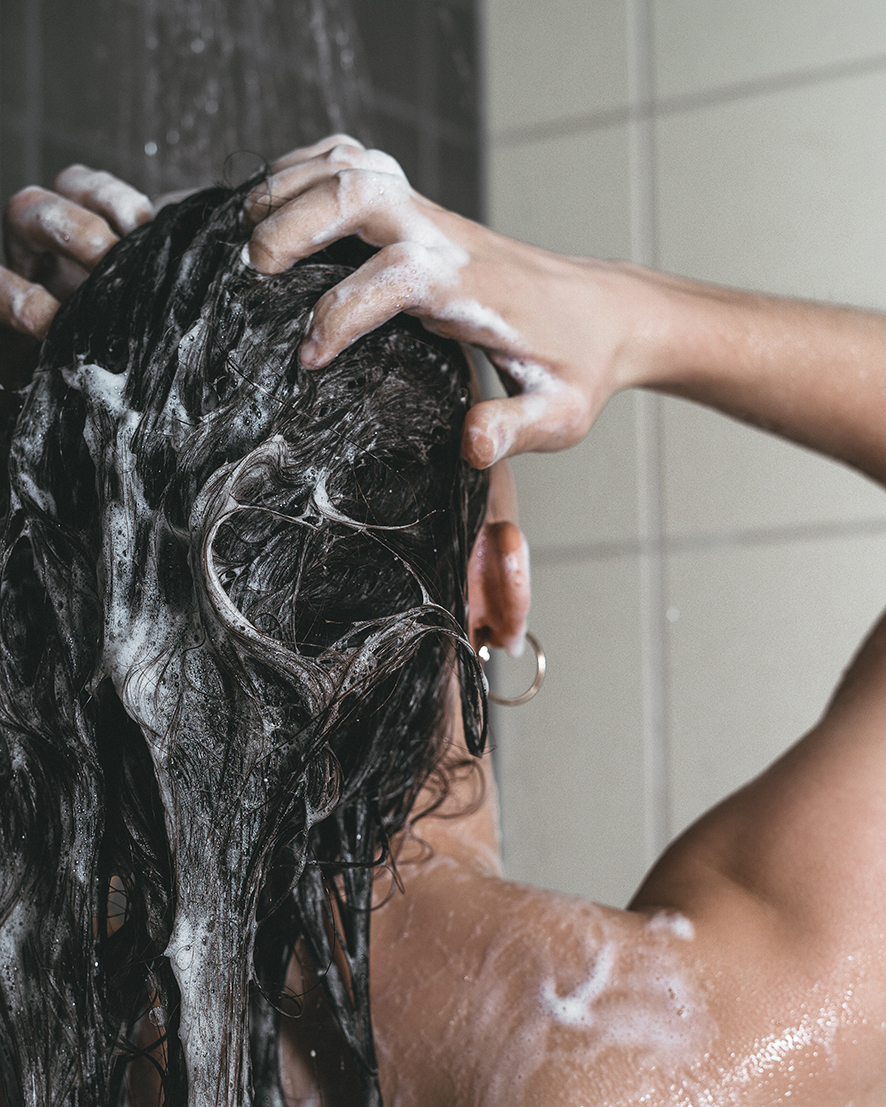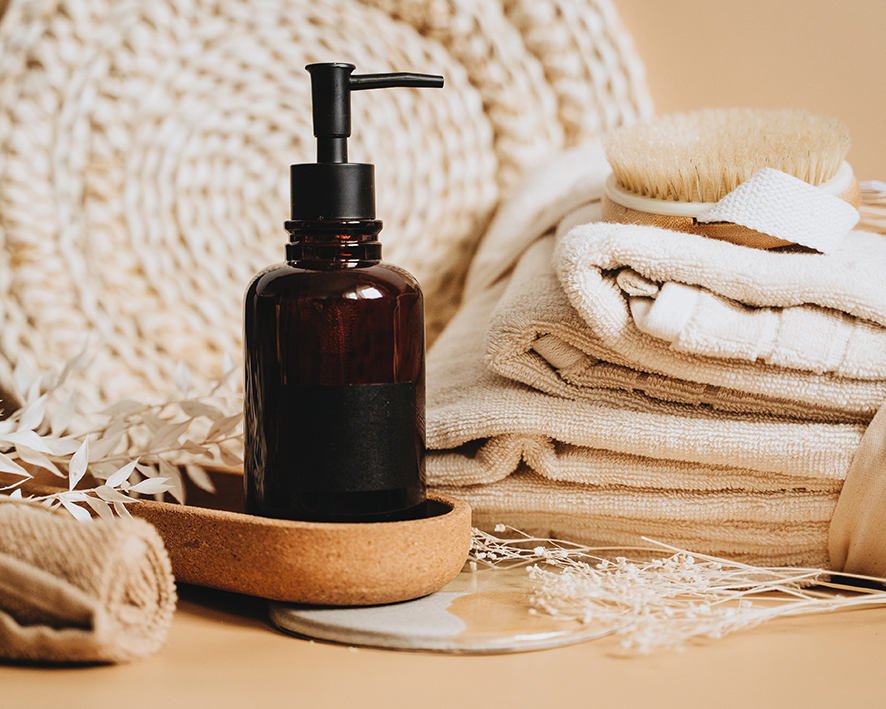Homemade hair shampoo for beginners
Homemade shampoo for fine hair you can make at home even as a beginner.
It's quite simple.
You too can easily, in the comfort of your own home, make homemade shampoo for fine hair. The production is not complicated at all and is suitable even for beginners. In addition to getting an accurate overview of the ingredients
in your cosmetic product, you can customise your homemade shampoo according to your needs.

INGREDIENTS
65,5 % Distilled water
5% Glycerine
5 % Cottonseed oil
20 % Coco glucoside
1 % Xanthan gum
2,5 % Citric acid
1 % Euxyl PE 9010 - preservative
HOMEMADE HAIR SHAMPOO AND PROCEDURE
1. disinfect all containers and utensils you will use.
2. weigh the glycerine and xanthan gum into a bowl or beaker, mix well until a thick slurry is formed, which will later thicken your homemade shampoo.
3.in a second container, dissolve the citric acid in the water. Then add coco glucoside
and stir.
4. pour the aqueous mixture into the container with the glycerin and xanthan gum, add the oil and stir.
5.finally, add the preservative.
HOMEMADE HAIR SHAMPOO AND ITS USES
Thanks to its coco glucoside tenside content, this simple homemade shampoo gently degreases, which is why it is particularly useful for washing hair that is not strongly prone to greasiness. For greasier hair, two doses should be used when washing. The homemade shampoo is designed for beginners, so you will find only the necessary ingredients, e.g.however, you can make it more effective by adding active ingredients suitable for shampoos.
Even though the recipe for homemade hair shampoo includes a preservative, of course, the product will not last you forever. If you notice changes in colour, texture or smell after a while, don't use the product any further.

HOMEMADE HAIR SHAMPOO AND ITS COMPOSITION
The individual ingredients that the homemade shampoo contains have their own distinctive properties, and also the meaning of why they are included in the recipe. Knowing their importance will help you to know how to alter them or adjust their dosage, if necessary.
GLYCERINE AND XANTHAN GUM
These two ingredients occur together in a recipe for homemade shampoo because together they help to thicken the final product. Xanthan gum is a thickening agent that needs to be partially hydrated in glycerin before adding water so that you don't get lumps in the final product. However, even if this happens, don't despair, there is still a chance that the xanthan gum will dissolve over time (after it has bound water to itself), especially if you have used it in smaller quantities.
Use the xanthan gum content to control the fluidity of the final product. If you find your homemade shampoo too thin, increase the xanthan gum content (ideally up to 2%). Alternatively, if you want a more fluid homemade shampoo, change the xanthan gum content to 0,75 % to 0,5 %.
COCO GLUCOSIDE
Coco glucoside is an essential cleansing and foaming agent in a homemade shampoo recipe. It is in fact
is a tenside that also has partial emulsifying properties, which is why the oil is also found in the recipe for homemade shampoo without the use of an additional emulsifier.
Coco glucoside is a mildly degreasing tenside, so homemade shampoo may not suit people
with greasier hair. Conversely, if you find the shampoo too degreasing, reduce the coco glucoside content, remember to use a shampoo that is not very gentle on the hair.also reduce the citric acid content so that the final product is not too acidic.
CITRIC ACID
Since coco glucoside has an acalytic pH, therefore citric acid is also included in the recipe for homemade shampoo to lower the pH. An alkaline pH could irritate the skin. Also for this reason, it's a good idea to check the pH of the final product at least with pH paper to make sure your product is not too alkaline.
COTTONSEED OIL
Cottonseed oil is extracted by pressing the seeds of the cotton plant, which are a by-product of cotton production. It is suitable for dry and damaged hair, especially because of its moisturising effects, which is also why it is a good ingredient for homemade shampoo.

HOMEMADE HAIR SHAMPOO AND ITS VARIATIONS
As we mentioned, the recipe for homemade shampoo is suitable for beginners, because you do not need a lot of complicated ingredients to make it. However, if you want to spice up your shampoo or adapt it to your hair type, it is possible to vary or add some of the ingredients.
HYDROLATES
Flower hydrolates serve as a substitute for the distilled water that home shampoo contains. Each hydrolate has its own specific properties and effects on the hair, depending on which plant it has been extracted from. You can thus easily adapt your homemade shampoo to your needs.
PLANT OILS
Your shampoo doesn't have to contain just one type of vegetable oil. You can use different blends of cold-pressed or refined vegetable oils. Again, you can match your choice of oil for your homemade shampoo
with your hair type.
You can slow down the oxidation process of the oils, and thus prolong their life, through the addition of vitamin E. However, since homemade shampoo does not contain a large amount of oil, this is not necessary unless you have vitamin E on hand.
ESSENTIAL OILS
If you want your homemade shampoo to smell nice, you can use essential oils. With these, however, it is important to follow the recommended dosage for the specific type of oil to avoid unnecessary irritation.
Fragrance oils are an alternative to essential oils. These synthetically prepared oils can scent your homemade shampoo with a variety of exotic or fruity fragrances.
CONSERTVANT
If you don't have Euxyl PE 9010 on hand, you can also reach for another preservative suitable for home cosmetics. However, you need to be careful whether thepreservative will also be effective at the particular pH of the product. That's why it's a good idea to check your home shampoo, for example with pH papers, to be sure,
that the chosen preservative will be effective.
ACTIVE INGREDIENTS
Another option to personalise your homemade shampoo is to add active ingredients. Choose the substances,
that are suitable for use in hair cosmetics, also make sure that they will be effective at the pH of the product, or that they do not have other specific properties that need to be taken into account. A popular ingredient is keratin, which is also a natural component of the hair and helps to restore it.
NOTICE
As mentioned, you can experiment with homemade recipes to achieve the desired properties. However, many factors such as humidity, temperature, quality of ingredients and storage can affect the end result.
Before using any raw material to make a cosmetic product, familiarise yourself with
its properties, recommended dosage, storage conditions or safe handling. Any raw material may have the potential to cause an allergic reaction in sensitive individuals, so before using a product, we recommend that you find out if you suffer from an allergy to any of the raw materials or the overall product, e.g. by a skin test.
If you have very sensitive or very acne-prone skin, or other skin and health problems, we recommend that you consult a medical professionalbefore applying a new product to your skin, whether it is a homemade cosmetic product, a pure raw material or a commercially available product.
HOME-MADE HAIR SHAMPOO AND CONCLUSION
Has this homemade shampoo transformed your fine hair into long, goldilocks curls? Let us know
in the comments what you like about this homemade natural hair shampoo.
We look forward to hearing all of your thoughts.
Do the saponification, my friends.


